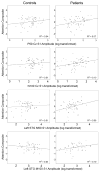Cognitive abilities and 50- and 100-msec paired-click processes in schizophrenia
- PMID: 20634366
- PMCID: PMC3272497
- DOI: 10.1176/appi.ajp.2010.09071059
Cognitive abilities and 50- and 100-msec paired-click processes in schizophrenia
Erratum in
- Am J Psychiatry. 2011 Sep;168(9):991
Abstract
Objective: Abnormal 50- and 100-msec event-related brain activity derived from paired-click procedures are well established in schizophrenia. There is little agreement on whether group differences in the ratio score, i.e., the ratio of EEG amplitude after the second stimulus (S2) to the amplitude after the first stimulus (S1), reflect an encoding or gating abnormality. In addition, the functional implications remain unclear. In the present study, EEG and magnetoencephalography (MEG) were used to examine paired-click measures and cognitive correlates of paired-click activity.
Method: EEG and whole-cortex MEG data were acquired during the standard paired-click paradigm in 73 comparison subjects and 79 schizophrenia patients. Paired-click ratio scores were obtained at 50 msec (P50 evoked potential at Cz, M50 at left and right superior temporal gyrus [STG]) and 100 msec (N100 at Cz, M100 at left and right STG). A cognitive battery assessing attention, working memory, and long-delay memory was administered. IQ was also estimated.
Results: Groups differed on ratio score and amplitude of S1 response. Ratio scores at 50 msec and 100 msec and S1 amplitude predicted variance in attention (primarily S1 amplitude), working memory, and long-delay memory. The attention findings remained after removal of variance associated with IQ.
Conclusions: Associations between paired-click measures and cognitive performance in patients support 50-msec and 100-msec ratio and amplitude scores as clinically significant biomarkers of schizophrenia. In general, cognitive performance was better predicted by the ability to encode auditory information than the ability to filter redundant information.
Figures


References
-
- Adler LE, Pachtman E, Franks RD, Pecevich M, Waldo MC, Freedman R. Neurophysiological Evidence for A Deficit in Inhibitor Mechanisms Involved in Sensory Gating in Schizophrenia. Biol Psychiatry. 1982;17:639–654. - PubMed
-
- Patterson JV, Hetrick WP, Boutros NN, Jin Y, Sandman C, Stern H, Potkin S, Bunney WE. P50 sensory gating ratios in schizophrenics and controls: A review and data analysis. Psychiatry Research. 2008;158:226–247. - PubMed
-
- Erwin RJ, Turetsky BI, Moberg P, Gur RC, Gur RE. P50 abnormalities in schizophrenia: relationship to clinical and neuropsychological indices of attention. Schizophr Res. 1998;33:157–167. - PubMed
-
- Cullum CM, Harris JG, Waldo MC, Smernoff E, Madison A, Nagamoto HT, Griffith J, Adler LE, Freedman R. Neurophysiological and neuropsychological evidence for attentional dysfunction in schizophrenia. Schizophr Res. 1993;10:131–141. - PubMed
Publication types
MeSH terms
Grants and funding
LinkOut - more resources
Full Text Sources
Medical
Research Materials

